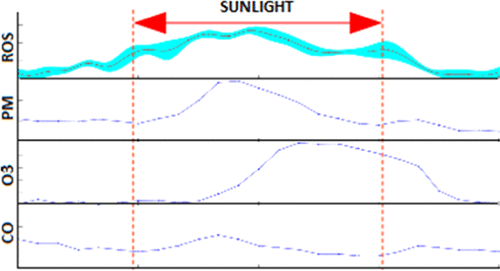当前位置:
X-MOL 学术
›
Environ. Sci. Technol.
›
论文详情
Our official English website, www.x-mol.net, welcomes your feedback! (Note: you will need to create a separate account there.)
Relationship between Atmospheric PM-Bound Reactive Oxygen Species, Their Half-Lives, and Regulated Pollutants: Investigation and Preliminary Model.
Environmental Science & Technology ( IF 11.4 ) Pub Date : 2020-03-30 , DOI: 10.1021/acs.est.9b06643 Reece A Brown 1 , Svetlana Stevanovic 1, 2 , Steven Bottle 3 , Hao Wang 4, 5 , Ziyuan Hu 4 , Changda Wu 1, 5 , Boguang Wang 4, 5 , Zoran Ristovski 1, 3, 5
Environmental Science & Technology ( IF 11.4 ) Pub Date : 2020-03-30 , DOI: 10.1021/acs.est.9b06643 Reece A Brown 1 , Svetlana Stevanovic 1, 2 , Steven Bottle 3 , Hao Wang 4, 5 , Ziyuan Hu 4 , Changda Wu 1, 5 , Boguang Wang 4, 5 , Zoran Ristovski 1, 3, 5
Affiliation

|
The concentration, nature, and persistence of particulate matter (PM)-bound reactive oxygen species (ROS) are of significant interest in understanding how atmospheric pollution affects health. However, the inherent difficulties in their measurement, particularly regarding the so-called "short-lived" ROS, have limited our understanding of their persistence and concentrations in the atmosphere. This paper aims to address this limitation through the analysis of PM-bound ROS measurements from the Particle Into Nitroxide Quencher (PINQ) system at an atmospheric monitoring site in the city of Heshan, Guangdong Province, China. The measured daily average and standard deviation for the measurement period was 0.050 ± 0.017 nmol·m-3. The averaged measured concentration of ROS per mass of PM and standard deviation was 0.0012 ± nmol·mg. The dataset was also correlated with standard pollutants, and a simplified model was constructed to separate the contributions of short-lived (t1/2 = 5 min) and long-lived (t1/2 ∼ infinity) ROS to total concentration using ozone, carbon monoxide, and PM mass. This showed that the short-lived ROS contribute an average of 33% of the daily PM-bound ROS burden over the measurement period, up to 52% of daily average on elevated days, and up to 71% for hourly averages. These results highlight the need for accurate measurements of short-lived ROS and provide the starting point for a general model to predict PM-bound ROS concentrations using widely available standard pollutants for future epidemiological research.
中文翻译:

大气PM结合的活性氧种类,其半衰期与受控污染物之间的关系:调查和初步模型。
与颗粒物质(PM)结合的活性氧(ROS)的浓度,性质和持久性对于了解大气污染如何影响健康具有重大意义。然而,它们的测量固有的困难,特别是关于所谓的“短寿命” ROS的测量,限制了我们对其在大气中的持久性和浓度的理解。本文旨在通过分析位于广东省鹤山市的大气监测点的颗粒进入一氧化氮猝灭剂(PINQ)系统中的PM结合ROS测量来解决这一限制。在整个测量期间内测得的每日平均值和标准偏差为0.050±0.017 nmol·m-3。每质量PM的ROS的平均测量浓度和标准偏差为0.0012±nmol·mg。该数据集还与标准污染物相关联,并构建了一个简化模型,以使用臭氧,碳来区分短期(t1 / 2 = 5分钟)和长期(t1 / 2〜无穷大)ROS对总浓度的贡献一氧化碳和PM质量。这表明,在测量期内,寿命短的ROS平均每天承担PM约束的ROS负担的33%,在升高的日子中最多承担每日平均的52%,每小时平均值最多承担71%。这些结果凸显了对短寿命ROS进行精确测量的需求,并为使用未来可进行流行病学研究的广泛使用的标准污染物预测PM结合ROS浓度的通用模型提供了起点。并建立了一个简化的模型,使用臭氧,一氧化碳和PM质量,将短期(t1 / 2 = 5分钟)和长期(t1 / 2〜无穷大)ROS对总浓度的贡献分开。这表明,在测量期内,寿命短的ROS平均每天承担PM约束的ROS负担的33%,在升高的日子中最多承担每日平均的52%,每小时平均值最多承担71%。这些结果凸显了对短寿命ROS进行精确测量的需求,并为使用未来可进行流行病学研究的广泛使用的标准污染物预测PM结合ROS浓度的通用模型提供了起点。并建立了一个简化的模型,使用臭氧,一氧化碳和PM质量,将短期(t1 / 2 = 5分钟)和长期(t1 / 2〜无穷大)ROS对总浓度的贡献分开。这表明,在测量期内,寿命短的ROS平均每天承担PM约束的ROS负担的33%,在升高的日子中最多承担每日平均的52%,每小时平均值最多承担71%。这些结果凸显了对短寿命ROS的准确测量的需求,并为使用将来可用于流行病学研究的广泛使用的标准污染物来预测PM结合的ROS浓度的通用模型提供了起点。这表明,在测量期内,寿命短的ROS平均每天承担PM约束的ROS负担的33%,在升高的日子中最多承担每日平均的52%,每小时平均值最多承担71%。这些结果凸显了对短寿命ROS进行精确测量的需求,并为使用未来可进行流行病学研究的广泛使用的标准污染物预测PM结合ROS浓度的通用模型提供了起点。这表明,在测量期内,寿命短的ROS每天平均占PM约束的ROS负担的33%,在升高的日子中,每天的平均值高达52%,每小时的平均值高达71%。这些结果凸显了对短寿命ROS进行精确测量的需求,并为使用未来可进行流行病学研究的广泛使用的标准污染物预测PM结合ROS浓度的通用模型提供了起点。
更新日期:2020-04-23
中文翻译:

大气PM结合的活性氧种类,其半衰期与受控污染物之间的关系:调查和初步模型。
与颗粒物质(PM)结合的活性氧(ROS)的浓度,性质和持久性对于了解大气污染如何影响健康具有重大意义。然而,它们的测量固有的困难,特别是关于所谓的“短寿命” ROS的测量,限制了我们对其在大气中的持久性和浓度的理解。本文旨在通过分析位于广东省鹤山市的大气监测点的颗粒进入一氧化氮猝灭剂(PINQ)系统中的PM结合ROS测量来解决这一限制。在整个测量期间内测得的每日平均值和标准偏差为0.050±0.017 nmol·m-3。每质量PM的ROS的平均测量浓度和标准偏差为0.0012±nmol·mg。该数据集还与标准污染物相关联,并构建了一个简化模型,以使用臭氧,碳来区分短期(t1 / 2 = 5分钟)和长期(t1 / 2〜无穷大)ROS对总浓度的贡献一氧化碳和PM质量。这表明,在测量期内,寿命短的ROS平均每天承担PM约束的ROS负担的33%,在升高的日子中最多承担每日平均的52%,每小时平均值最多承担71%。这些结果凸显了对短寿命ROS进行精确测量的需求,并为使用未来可进行流行病学研究的广泛使用的标准污染物预测PM结合ROS浓度的通用模型提供了起点。并建立了一个简化的模型,使用臭氧,一氧化碳和PM质量,将短期(t1 / 2 = 5分钟)和长期(t1 / 2〜无穷大)ROS对总浓度的贡献分开。这表明,在测量期内,寿命短的ROS平均每天承担PM约束的ROS负担的33%,在升高的日子中最多承担每日平均的52%,每小时平均值最多承担71%。这些结果凸显了对短寿命ROS进行精确测量的需求,并为使用未来可进行流行病学研究的广泛使用的标准污染物预测PM结合ROS浓度的通用模型提供了起点。并建立了一个简化的模型,使用臭氧,一氧化碳和PM质量,将短期(t1 / 2 = 5分钟)和长期(t1 / 2〜无穷大)ROS对总浓度的贡献分开。这表明,在测量期内,寿命短的ROS平均每天承担PM约束的ROS负担的33%,在升高的日子中最多承担每日平均的52%,每小时平均值最多承担71%。这些结果凸显了对短寿命ROS的准确测量的需求,并为使用将来可用于流行病学研究的广泛使用的标准污染物来预测PM结合的ROS浓度的通用模型提供了起点。这表明,在测量期内,寿命短的ROS平均每天承担PM约束的ROS负担的33%,在升高的日子中最多承担每日平均的52%,每小时平均值最多承担71%。这些结果凸显了对短寿命ROS进行精确测量的需求,并为使用未来可进行流行病学研究的广泛使用的标准污染物预测PM结合ROS浓度的通用模型提供了起点。这表明,在测量期内,寿命短的ROS每天平均占PM约束的ROS负担的33%,在升高的日子中,每天的平均值高达52%,每小时的平均值高达71%。这些结果凸显了对短寿命ROS进行精确测量的需求,并为使用未来可进行流行病学研究的广泛使用的标准污染物预测PM结合ROS浓度的通用模型提供了起点。


























 京公网安备 11010802027423号
京公网安备 11010802027423号